Razer Orca goes hunting
Razer, a game peripheral monster, has a very interesting approach to choosing names for new devices - mice are traditionally named after snakes, keyboards - in honor of spiders, rugs - in honor of beetles, and audio systems - in honor of fish, sharks and other shark mammals. Today we are talking about a new “bastard” called Orca - Wikipedia says that this was the name of the predatory killer whale from the sensational movie of the same name.

Under the cat, three devices and pretty girls;)
Generally, when I didn’t understand the features of these headphones, I thought it was the same Razer Megalodon , but without an external sound card and all the technologies resulting from it. That is such a simple gaming headset, quite budget.
')

But in fact, everything turned out a little different. The Razer Orca is not a headset (it doesn’t have a microphone), but the most ordinary headphones that almost completely resemble their “big brother”. Not only externally, but also constructively - the same thick and durable headband, the same metal rods, thanks to which the “ears” can be put on any head. The same braided wire (although slightly thinner), which does not freeze in the cold.

And, of course, those big “cups”, inside of which there are warm velvet ear cushions, from which the ears do not get tired and do not hurt. This is one of the few ears in which you can be without discomfort for a long time; The size of the ear cushions is very good - it is not as small as, for example, in Audio-Technica ATH-ES7 , but also not as large as in ATH-AD1000 from the same manufacturer.


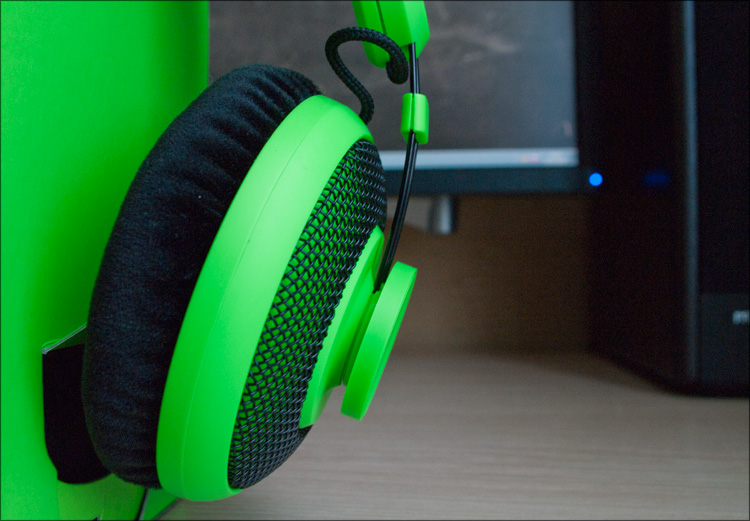
I see no point in re-describing the appearance - everything said in the Razer Megalodon review is valid for the Razer Orca. True, there are small differences - as I said, there is no rotary microphone and sound processing unit. Accordingly, there was no need for a USB-interface - it was replaced by the usual straight 3.5 mm mini-jack.

And once the power supply on this solemn note is over, then the whole illumination disappeared - in particular, the company logo in the form of three snakes:
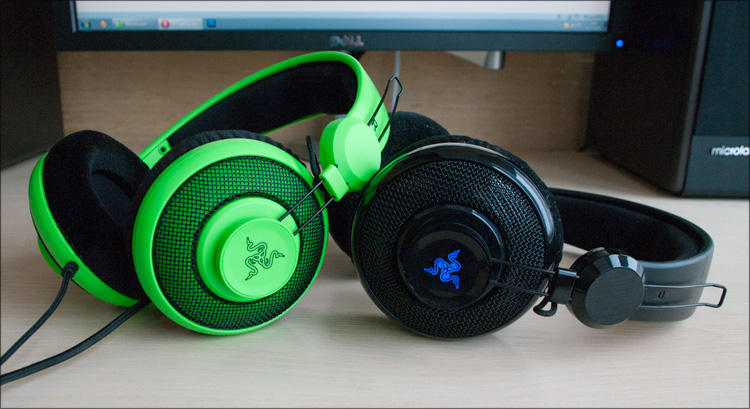
Usually Razer with fantasy fits the packaging of gadgets, but this time it's pretty simple - the headphones are half walled up in cardboard, the rest can be seen through a small cutout in the box. Components without frills - ears, extension cord and instruction. It's nice that this time the headphones completely get rid of the gloss. From the headphones (on the left side) there is one wire in a fabric braid - its length is 1.2 meters comfortable for the “portable”, although there is a two-meter extension cable in the set that can be “left” in the computer in order to connect the ears of the house to it. Docking the wire with the headphones themselves is very reliable, unlike the same expensive ATH-AD1000.


In terms of sound reproduction, the headphones are somewhat similar ... but if you compare ordinary music. Although such a comparison is somewhat incorrect due to different sound sources for any of the possible connection options. I mean detailing, bass and all of this topic is the same.
Finally, it was out to listen to these ears in a really noisy place - the insulation is good enough (the subway is almost inaudible), but many of the “gags”, as it should be, sound insulation will plug Orcs into the belt.
The differences begin in good-quality games, the developers of which at the development stage did not spare money for such an important part of the game as sound. In this scenario, Razer Megalodon is emerging as clear leaders - the Razer Maelstrom technology (which I wrote about in detail last time) really works wonders, dividing the whole sound into several channels and drinking it all in the ears - during the “crisis” you can hear who shoots from and in the same Need For Speed, Hot Pursuit is clearly audible, for example, that the spikes fly right behind the car, and not from somewhere in the astral. The processing of all this is not to the detriment of computer performance by an external data processing unit, to which sound control buttons are placed - since there is no such thing in the Razer Orca, they will not be able to replace the 7.1 system, even with a strong desire. It's just a headset ... on which, however, you can also play quite well. But if suddenly you are anelf of the 80th level, quite a pro and the sound in the game for you is not just a “background”, but a functional component, then it is better to play definitely on the “adult” model.

The Internet is somewhat misinformed, saying that there is software with ears for switching Gaming / Music modes, and also that there is a similar switch on the wire - there is neither one nor the other. On my photos, the color of the headphones is somewhat inaccurate - the green color is not as saturated as it really is;) Most accurately it is transmitted here .
I can say one thing - I have been using quite expensive Razer Megalodon headphones for over a year and have not yet found any serious flaws in them. They are initially positioned as gaming, but nothing prevents you from watching movies in them, listening to music, chatting on Skype or writing podcasts - the microphone is very OK there. An amazing box for transportation, a comfortable headphone stand ... I really liked everything! But, unfortunately, you don’t attach them to the player due to “linking to the hospital” - a USB connection, a non-removable signal processing unit ... and a microphone somewhere in the metro would look very ridiculous.
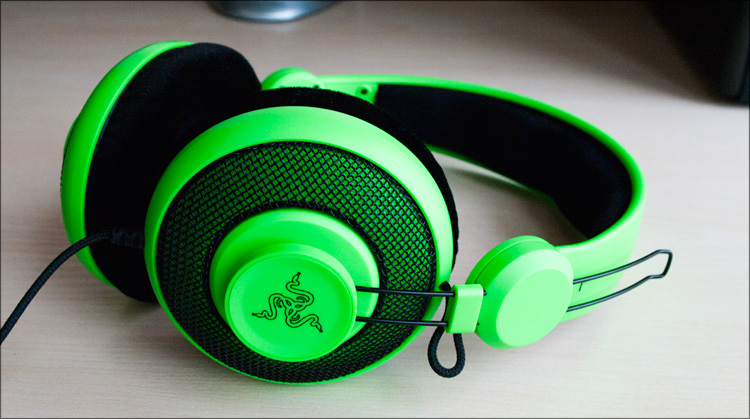
And then take and appear Razer Orca - aria from the same opera, but now in a portable version. The advantages remained in many ways, and the minuses turned into halves of the benefits - all this is now offered for three times less money, for 2600 rubles. It remains to hope that reliability will also be inherited from the older model, which “everyday” headphones will have to be very useful.
I don’t know how you would act, but with great pleasure in the winter period I changed the good sound insulation of the “plugs” to comfortable slippers that are warm and equally good-sounding Razer Orca. Conveniently and reliably sit on the head, not turning it into a "spacesuit" of enormous size. The only thing that causes some doubts is the acid green color ... I, as an agent Smith, dress mostly in black (I love this color because I haven't thought up a darker color) and the “poisonous headphones” completely harmonized my monotony with my riot of colors. But the reaction of friends was very ambiguous - from “ Wow, I like that - very unusual! "To" Uh, what kind of frivolous hipster shnyaga ?! ":) So it's up to you to decide - the color really breaks the patterns)


Frequency range : 15 - 21000 Hz
Maximum power consumption : 200 mW
Sensitivity (1 kHz, 1 V / Pa) : 102 ± 4 dB
Speakers : 40 mm, neodymium magnetic
Resistance : 32 ohms to 1 kHz
Connector : 3.5 mm mini jack, straight
Wire : 1.2 meters, in a protective sheath + extension cord to 2 meters

Well, since we started talking about the sound, let me briefly tell you about another device - I want to share my impressions, but I don’t want to make a separate post for this. In general, I collected a new computer for myself, gave the old to my wife - everything is OK, but without speakers. Skype, cartoons for a child or just music for the background - you can't do with headphones. To buy something high-quality / expensive - in this case it is completely useless, and the holidays have been thrown out of the rut. In general, chose by color)
Speedlink Vivente 2.1 - budget home acoustics, available in several colors. Inside a convenient (for transportation) box - a sub, two tiny speakers and wires. Absolutely everything is made of plastic, but after connecting it seemed to even work and seemed to be tolerable for its price (2100, a bit cheaper than the headphones I wrote about above). Frequency response is not, and if they need;)
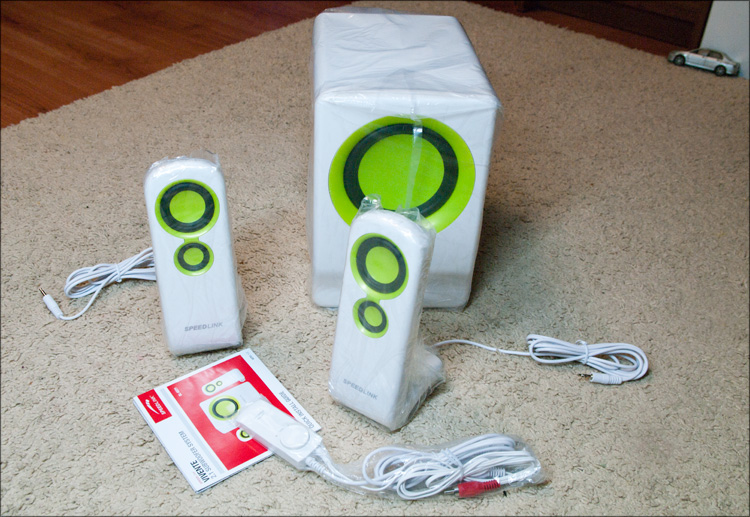
Everything connects to the subwoofer, including the "remote control", if you can call it that.
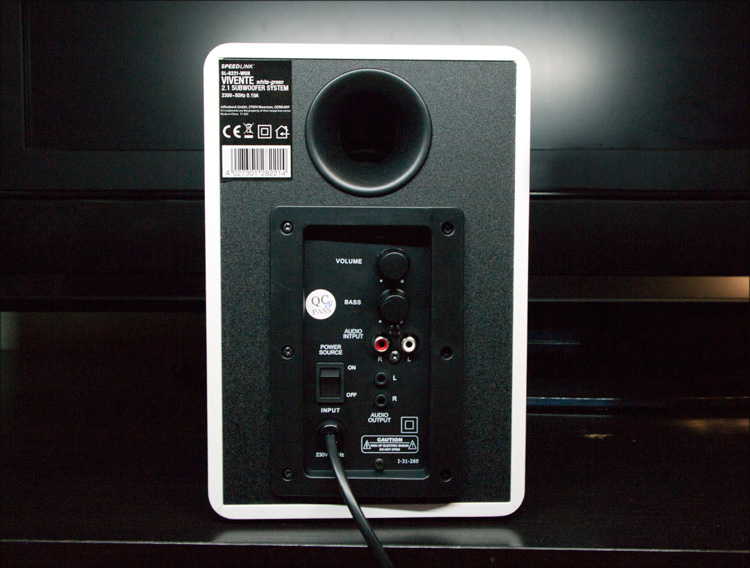
A small device with a volume control, to which for some reason there are already two wires, although, as practice has shown, they do everything with one.

Columns take up very little space, which was one of the key requirements when buying - despite the bizarre shape, they are pretty stable. Below they have a green LED that creates a pleasant glow around the speakers (in the dark).
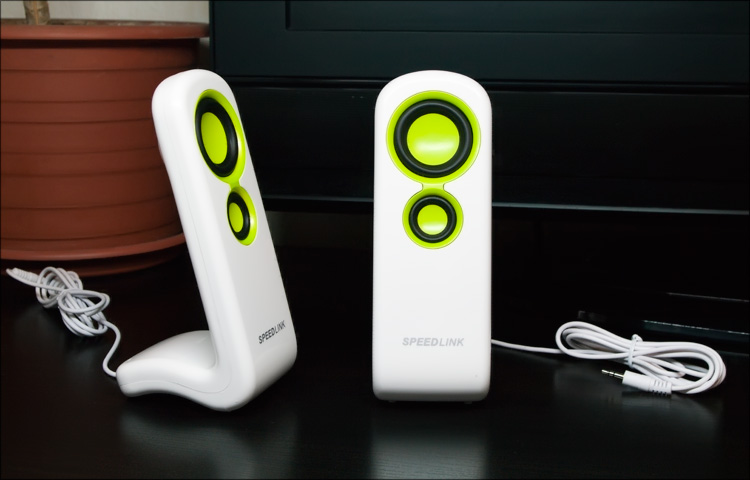
Not that I urge to buy these columns) But I bought them as consumables (a printer cartridge costs more), put it once and forgot it. The feeling of something frankly Chinese does not leave, but then the requirements were primitive. They cope with their task - so, as a budget option, somewhere for replacing laptop speakers, to the office, to the garage or just like us, home - completely.
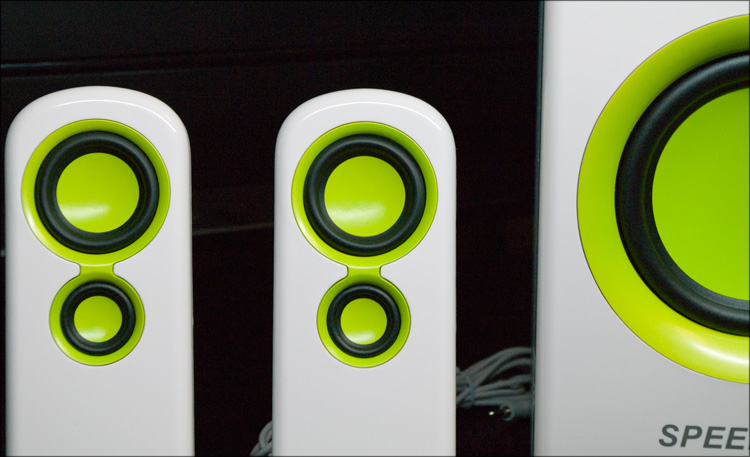
RMS output power : 12 W (satellites 2 x 3 W, subwoofer 6 W)
The operating frequency range of the satellites : 140 Hz - 20 kHz
The operating frequency range of the subwoofer : 40 Hz - 200 Hz
Resistance : satellites - 4 ohms, subwoofer - 6 ohms
Sizes of satellites : 70 x 195 x 95 mm
Subwoofer dimensions : 162 x 220 x 235 mm
Cable : 1.3 m
Weight : 2.5 kg
Everything.
These are the New Year's affairs. Tell me, what is better - to do a review while the piece of iron has just come out and another “fresh”, or is it careful to use it, but write more objectively? I am interested in your opinion, because the option “get it in a week and write a thorough fresh one” does not always work :)
PS I heard that Razer is preparing something tasty;)

Holiday greetings!

Under the cat, three devices and pretty girls;)
Generally, when I didn’t understand the features of these headphones, I thought it was the same Razer Megalodon , but without an external sound card and all the technologies resulting from it. That is such a simple gaming headset, quite budget.
')

But in fact, everything turned out a little different. The Razer Orca is not a headset (it doesn’t have a microphone), but the most ordinary headphones that almost completely resemble their “big brother”. Not only externally, but also constructively - the same thick and durable headband, the same metal rods, thanks to which the “ears” can be put on any head. The same braided wire (although slightly thinner), which does not freeze in the cold.

And, of course, those big “cups”, inside of which there are warm velvet ear cushions, from which the ears do not get tired and do not hurt. This is one of the few ears in which you can be without discomfort for a long time; The size of the ear cushions is very good - it is not as small as, for example, in Audio-Technica ATH-ES7 , but also not as large as in ATH-AD1000 from the same manufacturer.



I see no point in re-describing the appearance - everything said in the Razer Megalodon review is valid for the Razer Orca. True, there are small differences - as I said, there is no rotary microphone and sound processing unit. Accordingly, there was no need for a USB-interface - it was replaced by the usual straight 3.5 mm mini-jack.

And once the power supply on this solemn note is over, then the whole illumination disappeared - in particular, the company logo in the form of three snakes:

Usually Razer with fantasy fits the packaging of gadgets, but this time it's pretty simple - the headphones are half walled up in cardboard, the rest can be seen through a small cutout in the box. Components without frills - ears, extension cord and instruction. It's nice that this time the headphones completely get rid of the gloss. From the headphones (on the left side) there is one wire in a fabric braid - its length is 1.2 meters comfortable for the “portable”, although there is a two-meter extension cable in the set that can be “left” in the computer in order to connect the ears of the house to it. Docking the wire with the headphones themselves is very reliable, unlike the same expensive ATH-AD1000.


In terms of sound reproduction, the headphones are somewhat similar ... but if you compare ordinary music. Although such a comparison is somewhat incorrect due to different sound sources for any of the possible connection options. I mean detailing, bass and all of this topic is the same.
Finally, it was out to listen to these ears in a really noisy place - the insulation is good enough (the subway is almost inaudible), but many of the “gags”, as it should be, sound insulation will plug Orcs into the belt.
The differences begin in good-quality games, the developers of which at the development stage did not spare money for such an important part of the game as sound. In this scenario, Razer Megalodon is emerging as clear leaders - the Razer Maelstrom technology (which I wrote about in detail last time) really works wonders, dividing the whole sound into several channels and drinking it all in the ears - during the “crisis” you can hear who shoots from and in the same Need For Speed, Hot Pursuit is clearly audible, for example, that the spikes fly right behind the car, and not from somewhere in the astral. The processing of all this is not to the detriment of computer performance by an external data processing unit, to which sound control buttons are placed - since there is no such thing in the Razer Orca, they will not be able to replace the 7.1 system, even with a strong desire. It's just a headset ... on which, however, you can also play quite well. But if suddenly you are an

The Internet is somewhat misinformed, saying that there is software with ears for switching Gaming / Music modes, and also that there is a similar switch on the wire - there is neither one nor the other. On my photos, the color of the headphones is somewhat inaccurate - the green color is not as saturated as it really is;) Most accurately it is transmitted here .
I can say one thing - I have been using quite expensive Razer Megalodon headphones for over a year and have not yet found any serious flaws in them. They are initially positioned as gaming, but nothing prevents you from watching movies in them, listening to music, chatting on Skype or writing podcasts - the microphone is very OK there. An amazing box for transportation, a comfortable headphone stand ... I really liked everything! But, unfortunately, you don’t attach them to the player due to “linking to the hospital” - a USB connection, a non-removable signal processing unit ... and a microphone somewhere in the metro would look very ridiculous.

And then take and appear Razer Orca - aria from the same opera, but now in a portable version. The advantages remained in many ways, and the minuses turned into halves of the benefits - all this is now offered for three times less money, for 2600 rubles. It remains to hope that reliability will also be inherited from the older model, which “everyday” headphones will have to be very useful.
I don’t know how you would act, but with great pleasure in the winter period I changed the good sound insulation of the “plugs” to comfortable slippers that are warm and equally good-sounding Razer Orca. Conveniently and reliably sit on the head, not turning it into a "spacesuit" of enormous size. The only thing that causes some doubts is the acid green color ... I, as an agent Smith, dress mostly in black (I love this color because I haven't thought up a darker color) and the “poisonous headphones” completely harmonized my monotony with my riot of colors. But the reaction of friends was very ambiguous - from “ Wow, I like that - very unusual! "To" Uh, what kind of frivolous hipster shnyaga ?! ":) So it's up to you to decide - the color really breaks the patterns)


Specifications Razer Orca
Frequency range : 15 - 21000 Hz
Maximum power consumption : 200 mW
Sensitivity (1 kHz, 1 V / Pa) : 102 ± 4 dB
Speakers : 40 mm, neodymium magnetic
Resistance : 32 ohms to 1 kHz
Connector : 3.5 mm mini jack, straight
Wire : 1.2 meters, in a protective sheath + extension cord to 2 meters

Well, since we started talking about the sound, let me briefly tell you about another device - I want to share my impressions, but I don’t want to make a separate post for this. In general, I collected a new computer for myself, gave the old to my wife - everything is OK, but without speakers. Skype, cartoons for a child or just music for the background - you can't do with headphones. To buy something high-quality / expensive - in this case it is completely useless, and the holidays have been thrown out of the rut. In general, chose by color)
Speedlink Vivente 2.1 - budget home acoustics, available in several colors. Inside a convenient (for transportation) box - a sub, two tiny speakers and wires. Absolutely everything is made of plastic, but after connecting it seemed to even work and seemed to be tolerable for its price (2100, a bit cheaper than the headphones I wrote about above). Frequency response is not, and if they need;)

Everything connects to the subwoofer, including the "remote control", if you can call it that.

A small device with a volume control, to which for some reason there are already two wires, although, as practice has shown, they do everything with one.

Columns take up very little space, which was one of the key requirements when buying - despite the bizarre shape, they are pretty stable. Below they have a green LED that creates a pleasant glow around the speakers (in the dark).

Not that I urge to buy these columns) But I bought them as consumables (a printer cartridge costs more), put it once and forgot it. The feeling of something frankly Chinese does not leave, but then the requirements were primitive. They cope with their task - so, as a budget option, somewhere for replacing laptop speakers, to the office, to the garage or just like us, home - completely.

Specifications of Speedlink Vivente 2.1
RMS output power : 12 W (satellites 2 x 3 W, subwoofer 6 W)
The operating frequency range of the satellites : 140 Hz - 20 kHz
The operating frequency range of the subwoofer : 40 Hz - 200 Hz
Resistance : satellites - 4 ohms, subwoofer - 6 ohms
Sizes of satellites : 70 x 195 x 95 mm
Subwoofer dimensions : 162 x 220 x 235 mm
Cable : 1.3 m
Weight : 2.5 kg
Everything.
The end
These are the New Year's affairs. Tell me, what is better - to do a review while the piece of iron has just come out and another “fresh”, or is it careful to use it, but write more objectively? I am interested in your opinion, because the option “get it in a week and write a thorough fresh one” does not always work :)
PS I heard that Razer is preparing something tasty;)

Holiday greetings!
Source: https://habr.com/ru/post/110795/
All Articles